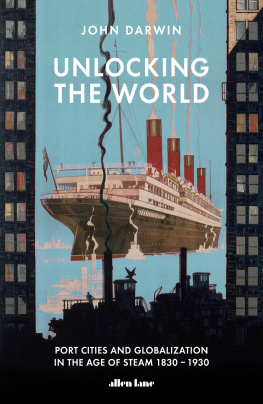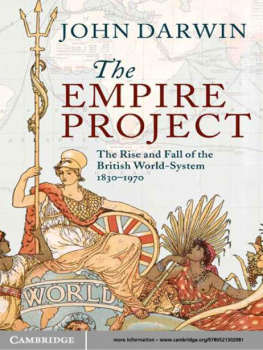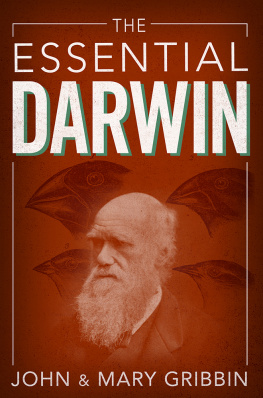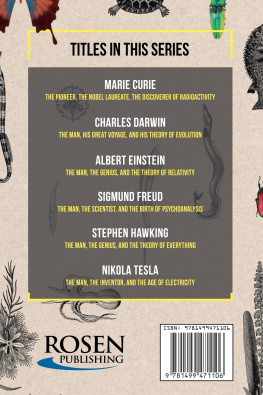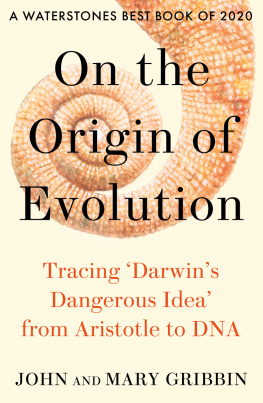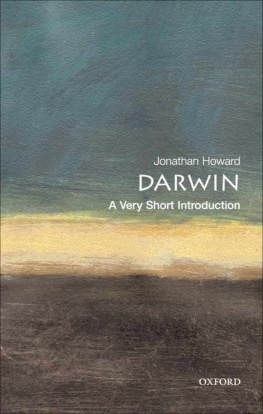John Darwin - Unlocking the World
Here you can read online John Darwin - Unlocking the World full text of the book (entire story) in english for free. Download pdf and epub, get meaning, cover and reviews about this ebook. year: 2020, genre: Politics. Description of the work, (preface) as well as reviews are available. Best literature library LitArk.com created for fans of good reading and offers a wide selection of genres:
Romance novel
Science fiction
Adventure
Detective
Science
History
Home and family
Prose
Art
Politics
Computer
Non-fiction
Religion
Business
Children
Humor
Choose a favorite category and find really read worthwhile books. Enjoy immersion in the world of imagination, feel the emotions of the characters or learn something new for yourself, make an fascinating discovery.
- Book:Unlocking the World
- Author:
- Genre:
- Year:2020
- Rating:3 / 5
- Favourites:Add to favourites
- Your mark:
- 60
- 1
- 2
- 3
- 4
- 5
Unlocking the World: summary, description and annotation
We offer to read an annotation, description, summary or preface (depends on what the author of the book "Unlocking the World" wrote himself). If you haven't found the necessary information about the book — write in the comments, we will try to find it.
Unlocking the World — read online for free the complete book (whole text) full work
Below is the text of the book, divided by pages. System saving the place of the last page read, allows you to conveniently read the book "Unlocking the World" online for free, without having to search again every time where you left off. Put a bookmark, and you can go to the page where you finished reading at any time.
Font size:
Interval:
Bookmark:



- PART ONE :
Making Global Connections - PART TWO :
The Dominion of Steam
John Darwin was until his retirement last year Professor of Imperial and Global History at the University of Oxford. He is the author of After Tamerlane, Unfinished Empire and The Empire Project.
In Memory of Jan-Georg Deutsch
: Sailing ships moored on the Hooghly River, from Views of Calcutta and Barrackpore, 1860s, by Samuel Bourne. ( British Library Board. All Rights Reserved/Bridgeman Images)
: Barrels of molasses, West India Docks, London, from Wonderful London, 19267, by Arthur St John Adcock. (The Print Collector/Print Collector/Getty Images)
Wapping, Elevated View of the Dock, 1803, by Thomas and William Daniell. ( British Library Board. All Rights Reserved. Bridgeman Images)
An ocean-going junk with listings of the sea route from China to Japan, c. 1850. (Pictures from History/Bridgeman Images)
A cog, depicted on a stained-glass window, fifteenth century. Muse de la ville de Bourges. ( Leonard de Selva/Bridgeman Images)
The Hongs at Canton, c. 1835, Chinese school. Taylor Gallery, London. (Bridgeman Images)
Great Eastern on the stocks in John Scott Russells yard at Millwall, 1857. Chromolithograph after a painting by J. Carmichael. (Universal History Archive/Getty Images)
Coaling a cruiser, St Lucia, West Indies, early 1900s. (Chronicle/Alamy)
A Birds-eye View of New-Orleans, c. 1851, by J. Bachmann. (Library of Congress Prints and Photographs Division Washington, DC)
Victoria Terminus, Bombay, late nineteenth century. (The Metropolitan Museum of Art, New York. Gift of Matthew Dontzin, 1985 (Acc. No. 1985.1168.11))
The harbour of the Singapore River crowded with junks and automobiles, c. 1930. (Bettmann/Getty Images)
Princes Dock, Liverpool, mid-twentieth century. (Stephen Shakeshaft/Liverpool Echo/Mirrorpix/Getty Images)
Evacuating Smyrna, 1922. (Bettmann/Getty Images)
Slow Boat from China
British Shipping in the Age of Sail
Sailing Routes in the North Atlantic
Routes to India and China
North Atlantic Trade Routes: Newfoundland Fisheries and West Indian Sugar
The Slave and Sugar Trades
Approaches to Canton
Gibraltar to Bombay
Cape of Good Hope to Canton
The South Atlantic Ocean in the Mid-Nineteenth Century
Shipping Routes and Submarine Cables, 1910
The Louisiana Purchase, 1803
The Cotton Kingdom in 1860
Approaches to New Orleans
North American Railways in 1860
The Hinterland Ambitions of Montreal Merchants
Montreal in the 1860s
New York Harbour
India c.1920
Bombay
Calcutta
Nanyang and China c.1900
Singapore in 1910
Shanghai in the 1860s
The Growth of Shanghais International Settlements
St Petersburg in 1910
Marseilles in 1910
London Docks in the 1860s
Liverpool Docks in the 1860s
Overlapping Hinterlands in Northern Europe
Antwerp in 1910
Hamburg
There are five keys that lock up the world, declared Admiral Jacky Fisher, grand strategist of the Edwardian Royal Navy: Singapore, the Cape of Good Hope, Alexandria, Gibraltar, Dover. Under Britains control, they would guard the sea lanes between Europe and the rest of the world and keep them safe from the fleets of any enemy power: a plan soon to be tested to destruction by U-boat warfare. Stationing the British Grand Fleet in the Orkneys completed Fishers design and sealed the last exit from the North Sea into the open ocean. In this book, we reverse Fishers image and change most of his places. The nineteenth century was the great age in which the coasts and ports of the world were freed from exclusions and closures; vast continental interiors were unlocked from the seclusion imposed by the costs of overland transport; and rivers whose hazards and currents made upstream traffic a toil (this included the River Seine until the 1840s) were opened by improvement and steam navigation. By the end of the steam century in 1930, regular, scheduled, travel by steamship and railway was possible to almost every closely inhabited part of the world, and so was the exchange of bulky low-cost goods. This was a revolution in world history with whose consequences we now live.
It had been a great technological achievement, the triumph of steam. But it was also a geopolitical trauma. The opening of continents in China, India, Australasia, the Americas, and in North and Central Asia, was consolidated by steam. But the doors had been forced by the armies, navies, settlers, serfs, slaves and indentured labour of the European empires and their American progeny the settler republics of Anglo- and Hispanic-America and the Empire of Brazil. Coercive diplomacy, military conquest, and the driving out (or enserfment) of indigenous peoples cleared the way for merchants, administrators, tax collectors, miners, planters, and yeoman or peasant farmers, closely followed by the teachers, priests and missionaries of different religions, the agents of cultural upheaval. By the time that steam was being properly harnessed to the carriage of people and goods over land and sea, a vast new terrain had been annexed to the commercial, administrative and settler empires of the emerging West.
This book had its origins in curiosity about the history of globalization, and of steam globalization in particular. It is framed by a number of key assumptions: that our globalization since 1990 is not unique, but only the latest in a series; that we can best understand its distinctive features by a knowledge of earlier versions; that globalizations are cumulative, but also subject to crises and reversals; that globalizations must be understood not (as we tend to do) as narrowly economic phenomena, but as the conjuncture of technological, commercial, cultural, ideological, geopolitical and environmental change, all of which give them their distinctive character. For what we exchange in globalization is not only goods, but also money, people, ideas, information, habits of consumption and biota: plants, animals and microbes. It is through their complex interaction that the quality of each globalization is formed. It follows logically from this that the catalyst of globalization, its regulator (to use a term from steam technology), is mobility the ease and speed with which things tangible and intangible can cross the wide spaces from one side of the world to the other.
Of paramount interest, historically and today, is the impact of globalization: what does it do to the people caught up in its toils, or to those left on its margins? Even to a casual glance, it is clear that it produces winners and losers, often reversing the fortunes of previous winners. Gain and loss might be felt in relative living standards, in cultural self-confidence, and in freedom or not from external domination. At its best it brings an all-round improvement in material well-being; at its worst, it might be a matter of life and death. Much historical debate has turned on the question of why some regions of the world were once prosperous but then sank into deep relative poverty. Just as intriguing is the question of how far globalizations have imposed greater cultural conformity or undermined the coherence of traditional cultures, sometimes with tragic effects. These questions can be asked of any era of globalization, but the focus of this book is on the steam century, when the spread and intensity of globalization offers the closest comparison to our own. It is also the period in which the sources and resources available for enquiry are richer than in any previous age.
Next pageFont size:
Interval:
Bookmark:
Similar books «Unlocking the World»
Look at similar books to Unlocking the World. We have selected literature similar in name and meaning in the hope of providing readers with more options to find new, interesting, not yet read works.
Discussion, reviews of the book Unlocking the World and just readers' own opinions. Leave your comments, write what you think about the work, its meaning or the main characters. Specify what exactly you liked and what you didn't like, and why you think so.

